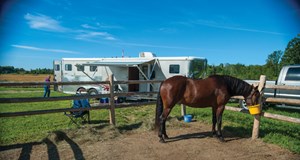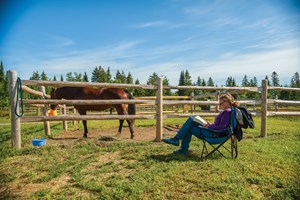You and your equine trail buddy are ready to plan your camping adventures. You’re over tent camping — you’ve invested in a living-quarters trailer and are ready to camp in style.

We travel seven to eight months a year with our horses, camping in our living quarters trailer. Here are a few nuggets we’ve gleaned from going down the road.
Plan Your Trip
In our travel planning, we look at how many miles a day we want to drive, then search for layover spots. We like to find large pens or corrals for the horses to stay in overnight. After a long day in the trailer, they appreciate room to stretch.
Generally, rodeo grounds and fairgrounds are good places to stay overnight with your horses. You can find contact information online or from the town’s chamber of commerce. You can also find places to stay in the Where-to-Ride Guide in every issue of The Trail Rider and online at TrailRiderMag.com (with live links).
Ask about the size of pens and horse water availability. Upon arrival, search the corral for nails, wire, and other potentially hazardous objects.
For your destination camp, look for a location that offers multiple trails that go directly out from one campsite. This allows for several days of varied riding without moving camp.

Check in advance for availability of horse water. Some locations in the West and Southwest that typically have streams may be dry due to drought.
Consider the available electrical, water, and sewer hookups. Look also for such amenities as campfire rings, picnic tables, indoor bathrooms, and showers. Bonus amenities include shaded campsites, a central gathering place, barns, arenas, wash racks, and stall bedding.
You may wish to camp far from the nearest town, or you might like to have stores and restaurants handy.
Plan Horse Containment
Some horse camps have corrals for your horse to stay in. Others do not. If you’ll be staying in a camp without corrals, you’ll need to plan how you’ll contain your horse.
Common horse-containment methods include a collapsible portable corral, an electric corral, a highline or picket line, and an overhead tie arm. Here’s a bit about each method.
• Portable corral. For overnight or day use, expandable portable corrals are a popular option. These corrals are available in metal (steel or aluminum), PVC pipe, and heavy-duty resin. We store our metal corral in the back of our pickup, but corrals can also be stashed on top of the trailer. The expandable panels form a 100-foot corral. However, we’ve found that our horses can bend the corral while trying to get grass on the other side, making it difficult to slide the corral back together. To prevent this, we simply string an electric line along the top of the corral.

• Electric portable corral. Electric portable corrals are easy to travel with and take just minutes for one person to set up and move to prevent overgrazing. Most electric corrals are assembled by running electric fence tape through fiberglass stakes. The whole system is then electrified by a battery-operated charger. If you go this route, accustom your horse to the corral at home, so he’ll respect it on the road. Left overnight, untrained horses may simply crash right out of an electric corral.
• Highline/picket line. A highline is at least seven feet high and allows horses to move around underneath it. A picket line is like a hitching rail and set at chest height — high enough that the horses can’t climb over it, but low enough that they can’t go under it, either. Select an area for your line that has good footing and is free of vegetation. Wet areas are especially vulnerable to hoof damage. Never tie your saddled horse to your line; the saddle could get caught on the rope, causing him to panic. Tie your horse so his head can reach about two feet off the ground. This will give him enough slack to lie down, but not enough to get himself tangled in the rope.
• Overhead tie arm. For a quick, easy setup, we use an overhead tie arm, which is a heavy-duty fiberglass rod that attaches to your trailer. You fold it out, then tie your horse to it, much like a highline. Your horse can turn around and even lie down. You can hang hay bags on your trailer below the ties, so your horse has access to his feed.
Consider Feed
When traveling with your horse, try to keep the same feed, or switch feeds slowly. An abrupt switch in feed may increase his colic risk. We feed grass hay. On the road, we add a cup of bran and an ounce of electrolytes, with some complete feed morning and night.

Bran helps to soften the stool, decreasing chance of colic. Electrolytes (salts) cause our horses to drink more frequently, once again decreasing chance of colic. Consult your veterinarian for feeding details.
Check local requirements for weed-free feed. Generally, but not always, weed-free feed is required in western states. Bring along enough water and food for yourselves, as well as water and feed for your horse, so that you can stay as long as you desire.
Consider using a slow feeder during camping travels. This type of feeder helps prevent hay from getting on the ground, greatly reducing waste. On sandy soil, a slow feeder will lessen the chance of sand colic.
Check Your Rig
Just before you leave, perform a trailer and tow-vehicle check. Check tire condition and air pressure, emergency brake, trailer brake, lights, turn signals, safety chains, and hitch condition.
Make sure everything is connected, the doors are shut, the electric cord is plugged in, and all horses are secured. Believe it or not, we’ve heard of people driving off with the back trailer door open. One time, we drove off with a water hose hanging out of the pickup. It flopped around and knocked the valve stem off of a tire.
In Camp
When you arrive at your camp, be sure that you don’t locate your corral over an animal trail. Mayhem and mischief may result from deer, elk, or other animals going through the corral fence, even if it’s electric.
Also, check nearby trees for stability. Many trees in the western forests have been weakened by beetles and fire.

A few years ago, we were at a beautiful camp in Wyoming that had gorgeous old cottonwoods. A storm barreled in with roaring thunder and spears of lightning. We thought it would be entertaining to sit outside and watch the atmospheric display.
But soon, powerful winds swooped into camp and knocked down three nearby cottonwoods. We quickly relocated our trailer!
Just Go!
When all the planning is said and done, don’t worry about the fine details. Pull out of the driveway with your horse in tow, and head down the road. You can always modify and adjust as you go. During your travels, you’ll pick up useful ideas through experience and from fellow travelers. Just do it, and have fun!
Kent and Charlene Krone combine their interest in photojournalism with a passion for horses. They’ve sold photographs to magazines, books, calendars, postcards, and video producers for more than 20 years. (For a sampling, visit www.superstock.com, and type “supplier:1314” in the search box.) They enjoy sharing their horseback adventures in the United States and Western Canada. Reach them at kentandcharlene@gmail.com.






